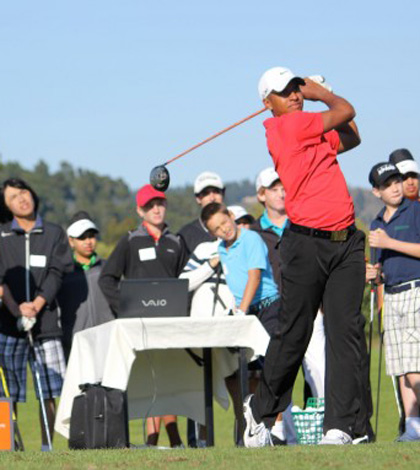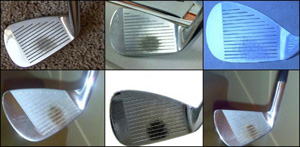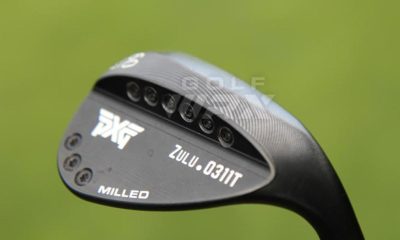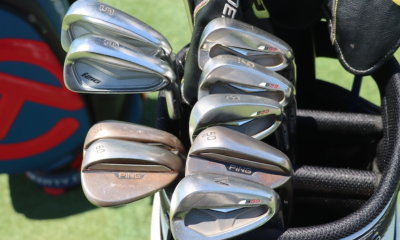Instruction
Increasing ball flight awareness

There is plenty of content out there explaining ball flight laws and why golf balls do as they do when struck. The problem is, many golfers still don’t understand them, so they spend valuable practice time less than effectively.
As a coach, I know the best thing is to book a program (not just swing lessons!) with your professional and make big changes where you are involved in the learning process. That way, you can start to discover and understand your own game. However, for the other 90 percent of the time, when you are golfing solo, you need to be able to understand the how and why of your ball flight. As Tiger’s instructor Sean Foley said recently, his goal is to allow the player to move away from being reliant on him as a coach. That’s going to be difficult to do without an understanding of the flight of your golf ball.
In this article, I will give some facts of impact and ball flight and explain how to analyze what you do. You may need to read this a few times over, so I suggest you don’t try to memorize it right away. This is not a test! Instead, use this as a benchmark to change your awareness. For ease of understanding, everything written is for a right-handed golfer. Don’t feel bad, lefties — you’ve got a lot going for you. Fewer people try to offer you swing advice on the range, and all you have to do is just flip my info around for it to make perfect sense.
First, you need to know that the flight of the golf ball is determined by four factors, which I’ll go into more detail about below:
- Club face orientation
- Club head direction
- Speed
- Point of contact
Club face orientation
 Depending on the club used and club head speed, the club face direction at impact (left/right/straight) has been shown to give between 60 to 95 percent of the ball’s starting direction. This also is the case with the club face’s dynamic loft (loft on the face at impact). Here, the ball launch angle is again, mostly influenced by the club face, rather than the angle of attack.
Depending on the club used and club head speed, the club face direction at impact (left/right/straight) has been shown to give between 60 to 95 percent of the ball’s starting direction. This also is the case with the club face’s dynamic loft (loft on the face at impact). Here, the ball launch angle is again, mostly influenced by the club face, rather than the angle of attack.
Easy tip: Although it’s not 100 percent accurate, in simple terms, club face = launch! When practicing, push an alignment stick into the ground 10 yards away from the ball, hit a shot and you can easily see the starting direction and therefore deduce the club face aim at impact.
Club head direction
Impact is very fast; as quick as 0.0004 seconds! Definitely not long enough to sense the club face position and try to correct it whilst the ball is on the face. The curve on a ball is predominantly due to the difference between the club face at impact and the direction of the swing path.
Easy tip: Imagine hitting a tennis shot or kicking a football…if the path is to the right of the face, the ball curves left. If the path is to the left of the face, the ball curves right.
Speed
Increased speed leads to higher spin rates, exaggeration of any tilting of the spin axis, more curvature, longer distances and higher shots. I am sure you all see young juniors at your course who never miss a fairway because they swing so slow. It does get a bit harder to hit it so straight with some extra speed for sure, but it is definitely possible with some extra understanding.
Easy tip: A good way to build some control with your swing and have some fun: Make some full swings but hit shots with 20 percent effort (great for working on swing changes) and then do the same at 95 percent and see how you get on before finding your best compromise between of distance and control. For you juniors out there…hit it hard and work on control afterward. Believe me, you will thank me later on when you have the control and the distance.
Contact Point
You know what I said about face and path? Well, just to confuse you, there is one more, very important factor: contact/impact point of club and ball in comparison to the center of gravity of the club. Many golfers strike the ball from the sweet spot much less often than they think and this influences ball flight hugely. A shot contacted off center on the face (due to something called horizontal gear effect) imparts spin on the ball which can exaggerate or reduce curvature. A toe shot increases curve to the left (or reduces curve to the right) and a heel shot increases curve to the right (or reduces curve to the left). Due to vertical gear effect, shots hit lower on the face tend to launch lower and have increased spin; contact high on the face leads to higher launch and reduced spin.
Easy tip: Check your contact point habits often, by simply using a whiteboard marker on the face.
My challenge to you: Next time you are on the range try to hit lots of different shots with differing heights, curves and launches. Use some of these tips to alter your face and path to affect ball flight and be more in control of your game. Focus on the result of the shots, not the technique that goes into it. Get some help from a coach who can help you with your exploration. Have fun and let me know how it goes!
- LIKE0
- LEGIT0
- WOW0
- LOL0
- IDHT0
- FLOP0
- OB0
- SHANK0
Instruction
Clement: Laid-off or perfect fade? Across-the-line or perfect draw?

Some call the image on the left laid off, but if you are hitting a fade, this could be a perfect backswing for it! Same for across the line for a draw! Stop racking your brain with perceived mistakes and simply match backswing to shot shape!
- LIKE0
- LEGIT0
- WOW0
- LOL0
- IDHT0
- FLOP0
- OB0
- SHANK1
Instruction
The Wedge Guy: The easiest-to-learn golf basic

My golf learning began with this simple fact – if you don’t have a fundamentally sound hold on the golf club, it is practically impossible for your body to execute a fundamentally sound golf swing. I’m still a big believer that the golf swing is much easier to execute if you begin with the proper hold on the club.
As you might imagine, I come into contact with hundreds of golfers of all skill levels. And it is very rare to see a good player with a bad hold on the golf club. There are some exceptions, for sure, but they are very few and very far between, and they typically have beat so many balls with their poor grip that they’ve found a way to work around it.
The reality of biophysics is that the body moves only in certain ways – and the particulars of the way you hold the golf club can totally prevent a sound swing motion that allows the club to release properly through the impact zone. The wonderful thing is that anyone can learn how to put a fundamentally sound hold on the golf club, and you can practice it anywhere your hands are not otherwise engaged, like watching TV or just sitting and relaxing.
Whether you prefer an overlap, interlock or full-finger (not baseball!) grip on the club, the same fundamentals apply. Here are the major grip faults I see most often, in the order of the frequency:
Mis-aligned hands
By this I mean that the palms of the two hands are not parallel to each other. Too many golfers have a weak left hand and strong right, or vice versa. The easiest way to learn how to hold the club with your palms aligned properly is to grip a plain wooden ruler or yardstick. It forces the hands to align properly and shows you how that feels. If you grip and re-grip a yardstick several times, then grip a club, you’ll see that the learning curve is almost immediate.
The position of the grip in the upper/left hand
I also observe many golfers who have the butt of the grip too far into the heel pad of the upper hand (the left hand for right-handed players). It’s amazing how much easier it is to release the club through the ball if even 1/4-1/2″ of the butt is beyond the left heel pad. Try this yourself to see what I mean. Swing the club freely with just your left hand and notice the difference in its release from when you hold it at the end of the grip, versus gripping down even a half inch.
To help you really understand how this works, go to the range and hit shots with your five-iron gripped down a full inch to make the club the same length as your seven-iron. You will probably see an amazing shot shape difference, and likely not see as much distance loss as you would expect.
Too much lower (right) hand on the club
It seems like almost all golfers of 8-10 handicap or higher have the club too far into the palm of the lower hand, because that feels “good” if you are trying to control the path of the clubhead to the ball. But the golf swing is not an effort to hit at the ball – it is a swing of the club. The proper hold on the club has the grip underneath the pad at the base of the fingers. This will likely feel “weak” to you — like you cannot control the club like that. EXACTLY. You should not be trying to control the club with your lower/master hand.
Gripping too tightly
Nearly all golfers hold the club too tightly, which tenses up the forearms and prevents a proper release of the club through impact. In order for the club to move back and through properly, you must feel that the club is controlled by the last three fingers of the upper hand, and the middle two fingers of the lower hand. If you engage your thumbs and forefingers in “holding” the club, the result will almost always be a grip that is too tight. Try this for yourself. Hold the club in your upper hand only, and squeeze firmly with just the last three fingers, with the forefinger and thumb off the club entirely. You have good control, but your forearms are not tense. Then begin to squeeze down with your thumb and forefinger and observe the tensing of the entire forearm. This is the way we are made, so the key to preventing tenseness in the arms is to hold the club very lightly with the “pinchers” — the thumbs and forefingers.
So, those are what I believe are the four fundamentals of a good grip. Anyone can learn them in their home or office very quickly. There is no easier way to improve your ball striking consistency and add distance than giving more attention to the way you hold the golf club.
More from the Wedge Guy
- The Wedge Guy: Golf mastery begins with your wedge game
- The Wedge Guy: Why golf is 20 times harder than brain surgery
- The Wedge Guy: Musings on the golf ball rollback
- LIKE88
- LEGIT14
- WOW6
- LOL1
- IDHT0
- FLOP4
- OB1
- SHANK8
Instruction
Clement: Stop ripping off your swing with this drill!

Not the dreaded headcover under the armpit drill! As if your body is defective and can’t function by itself! Have you seen how incredible the human machine is with all the incredible feats of agility all kinds of athletes are accomplishing? You think your body is so defective (the good Lord is laughing his head off at you) that it needs a headcover tucked under the armpit so you can swing like T-Rex?
- LIKE0
- LEGIT3
- WOW2
- LOL0
- IDHT0
- FLOP0
- OB0
- SHANK2
-

 19th Hole1 week ago
19th Hole1 week agoJustin Thomas on the equipment choice of Scottie Scheffler that he thinks is ‘weird’
-

 19th Hole1 week ago
19th Hole1 week ago‘Absolutely crazy’ – Major champ lays into Patrick Cantlay over his decision on final hole of RBC Heritage
-

 19th Hole2 weeks ago
19th Hole2 weeks agoTwo star names reportedly blanked Jon Rahm all week at the Masters
-

 19th Hole2 weeks ago
19th Hole2 weeks agoReport: LIV Golf identifies latest star name they hope to sign to breakaway tour
-

 19th Hole2 weeks ago
19th Hole2 weeks agoNeal Shipley presser ends in awkward fashion after reporter claims Tiger handed him note on 8th fairway
-

 19th Hole2 weeks ago
19th Hole2 weeks agoBrandel Chamblee has ‘no doubt’ who started the McIlroy/LIV rumor and why
-

 Equipment3 weeks ago
Equipment3 weeks agoWhat we know about Bryson DeChambeau’s 3D-printed Avoda irons
-

 19th Hole5 days ago
19th Hole5 days agoLET pro gives detailed financial breakdown of first week on tour…and the net result may shock you


















Andy Griffiths
Feb 6, 2013 at 3:24 pm
Mark: Yeah, that is exactly what I meant. This awareness of current habits and associating feeling with visible contact point is very important.
Great to hear and thanks for the feedback, I find very often that players improve quickly when they know what and why they are changing something! All my social media links are in profile, would be great to hear how you get on! Good luck.
3Puttnomore
Feb 6, 2013 at 12:36 pm
Can you explain about using the white board marker to check contact points… Do you mean record the observable contact point?
Great article!… I THRIVE when the reasons for things are explained to me. When I understand what’s going on behind the scenes and have it in my head, it’s much easier for me to know where I’ve gone wrong… or right!
Too much snow on the ground to try this stuff outside, but I’ll head to my local dome for some fun.
Again, thanks!
Mark Rice
Brampton, Ont.
Canada
Ben Alberstadt
Jan 31, 2013 at 9:51 am
“For you juniors out there…hit it hard and work on control afterward. Believe me, you will thank me later on when you have the control and the distance.” Classic, Nicklaus-esque tip. Nice breakdown of the components of ball flight, Mr. Griffiths.
@trackman: Great video. Thanks for the link!
Andy Griffiths
Jan 31, 2013 at 5:16 am
Thanks guys for the comments and good luck with your golf. Would be great to hear on here/twitter/facebook how you are going!
Paul: Launch monitors show that horizontal gear effect is definitely alive and well with irons too. The figures in terms of effect on spin axis tilt is definitely less than seen with woods but definitely will lead to draws, or reduce rightward curve.
Troy: It sounds like he definitely did; for me and my coaching, ball flight is vital! It is possible for divots to be misleading to where the true path is so just be a bit wary.
Troy Vayanos
Jan 30, 2013 at 2:21 pm
Good stuff Andy,
The first question my golf coach asked me was what was my normal ball flight. I guess he knew what he has doing!
Watching the direction of the divots can also be beneficial as well.
Cheers
Trackman
Jan 30, 2013 at 9:54 pm
“Watching the direction of the divots can also be beneficial as well.”
This is a false statement, the direction of a divot provides any golfer with minimal feedback to their path or angle of attack.
http://www.youtube.com/watch?v=IwBtqifZNJ8&playnext=1&list=PLiy9Az0E8GxcdrdYM32m8NXy0C3zzEO56&feature=results_video
Joe Mayo provides a great explanation of why a divot is not beneficial for a golfer to use as a sense of direction of the swing.
Paul Byrne
Jan 30, 2013 at 2:03 pm
Hi Andy,
Excellent article.
Be good if you could clarify how an off-centre hit affects woods and irons differently.
With woods hge will cause a toe hit to curve to the left. With irons there is hardly any hge, if any at all. A toe hit will cause ball to start further to right due to clockwise twisting or rotation of clubhead.
Cheers
Paul
Trackman
Jan 30, 2013 at 9:58 pm
It is a phenomena called gear effect. Reference the video previously attached.